Many businesses support customers across multiple countries and ethnic communities, and therefore need to provide customer service in a wide variety of local languages. It’s hard to consistently staff contact centers with agents with different language proficiencies. During periods of high call volumes, callers often must wait on hold for an agent who can speak their language.
What if these businesses could implement a system to act as a real-time translator, allowing customers and agents to easily communicate in different languages? With such a system, a customer could message a support agent in their native language, such as French, and the support agent could use their own native language, maybe Italian, to read and respond to the customer’s messages. Deliveroo, an online food delivery company based in England, has implemented a system that does exactly that!
Deliveroo provides food delivery in over 200 locations across Europe, the Middle East, and Asia, serving customers in dozens of languages. Previously, during periods of high demand (such as during televised sporting events, or bad weather) they would ask customers to wait for a native speaker to become available or ask their agents to copy/paste the chats into an online translation service. These approaches were far from ideal, so Deliveroo is now deploying a much better solution that uses Amazon Connect and Amazon Translate to implement scalable live agent chat with built-in automatic two-way translation.

In this post, we share an open-source version of this solution from one of Amazon’s partners, VoiceFoundry. We show you how to install and try the solution, and then how you can customize it to control translations of specific phrases. Finally, we share success stories from our customer, Deliveroo, and leave you with pointers for implementing a similar solution for your own business.
Set up an Amazon Connect test instance and live chat translation
Follow these tutorials to set up an Amazon Connect test instance and experiment with the chat contact feature:
- Tutorial 1: Set up your Amazon Connect instance
- Tutorial 2: Test the sample voice and chat experience
If you have an Amazon Connect test instance and you already know how to use chat contacts, you can skip this step.
Now that you have Amazon Connect chat working, it’s time to install the sample live chat translation solution. My co-author, Dan from VoiceFoundry, has made it easy. Follow the instructions in the project GitHub repository Install Translate CCP Demo for Amazon Connect.
Test the solution
To test the solution, you simulate two roles—the agent and the customer.
- As the agent, sign in to your Amazon Connect instance dashboard.
- In a separate browser window, open the new web application using the URL created when you installed the solution.
The Amazon Connect Control Panel is displayed on the left, and the new chat translation panel is on the right.
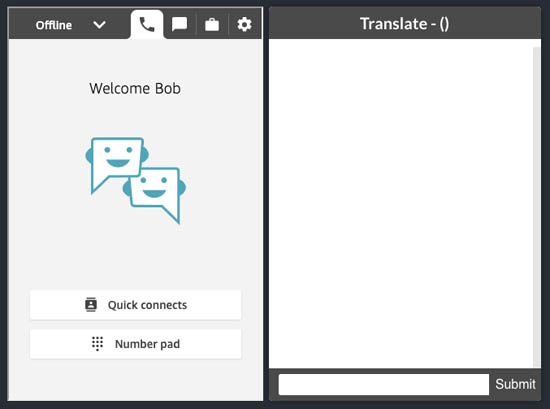
- On the Control Panel title bar, change your status from Offline to Available.
- Acting as the customer, launch the test chat page from the Amazon Connect dashboard, or using the URL
https://<yourConnectInstance>/connect/test-chat.
In a real-world application, you use a customer chat client widget on a website or mobile application. However, for this post, it’s convenient to use the test chat client.
- Open the customer test chat widget to initiate contact with the agent.
You hear a ring tone and see a visual indicator on the agent’s control panel as the agent is asked to accept your contact.
- As the agent, accept the incoming request to establish contact.
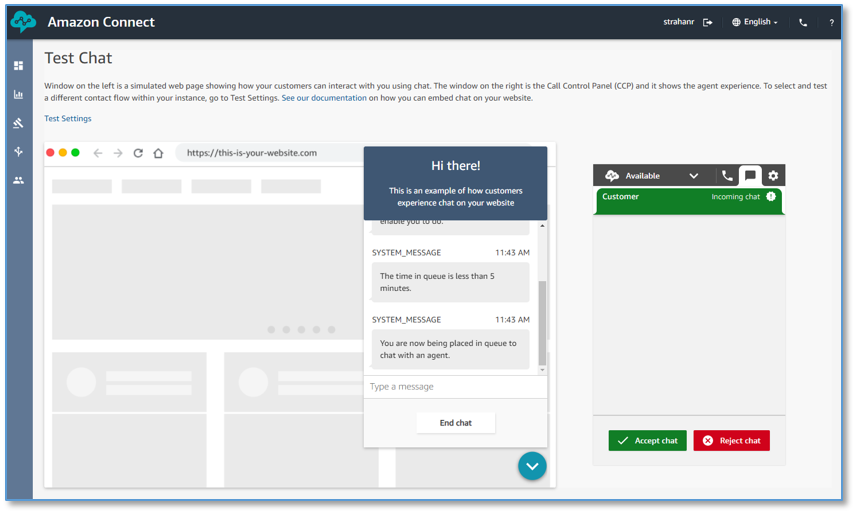
- As the customer, enter a message in Spanish into the customer test chat widget. For example, “Hola, necesito ayuda con mi pedido.”

Let’s assume that the agent can’t understand the incoming message in Spanish. Don’t worry—we can use our sample solution. The new web app chat translation panel displays the translation in English, along with the customer’s original message. Now you can understand the phrase “Hi, I need help with my order.”

- As the agent, enter a reply in English in the chat translation panel text box, for example “Hi, My name is Bob and I will be happy to help. What is your name and phone number?”
Your reply is automatically translated back to Spanish.
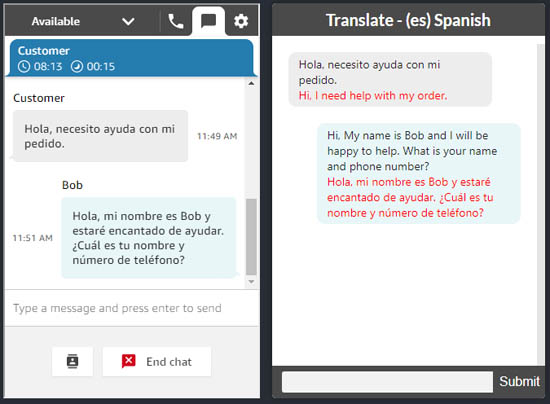
- As the customer, verify that you received a reply from the agent in Spanish.

Continue the conversation and observe how the customer can chat entirely in Spanish, and the agent entirely in English. Take a moment to consider how useful this can be.
When you’re done, as the agent, choose End chat and Close contact to end the chat session. As the customer, choose End chat.
Did you notice that the chat translation panel automatically identified the language the customer used—in this case Spanish? You can use any of the languages supported by Amazon Translate. Try the experiment again, this time using a different language for the customer. Have some fun with it—engage friends who are fluent in other languages and communicate with them in their native tongue.
In the sample application, we have assumed that the agent always uses English. A production version of the application would allow the agent to choose their preferred language.
Multi-chat support
Amazon Connect supports up to five concurrent chat sessions per agent. Our sample application allows a single agent to support multiple customer chats in different languages concurrently.
In the following screenshot, agent Bob is now chatting with a new customer, this time in German!
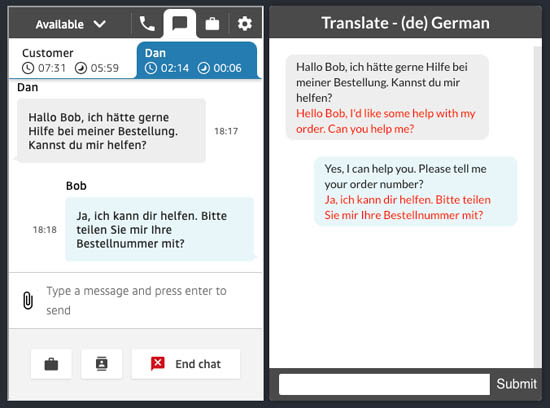
Customize terminology
Let’s say you have a product called Moonlight and Roses. While discussing this product with your Spanish-speaking customer, you enter something like “I see that you ordered Moonlight and Roses on May 13, is that correct?”
Your customer sees the translation “Veo que ordenaste Luz de Luna y Rosas el 13 de mayo, ¿es correcto?”
This is a good literal translation—Luz de Luna y Rosas does mean Moonlight and Roses. But in this case, you want your English product name, Moonlight and Roses, to be translated to the Spanish product name, Moonlight y Roses.
This is where we can use the powerful custom terminology feature in Amazon Translate. Let’s try it. For instructions on updating your custom terminologies, see the GitHub repo.
Now we can validate the solution with another simulated chat between an agent and customer, as in the following screenshot.
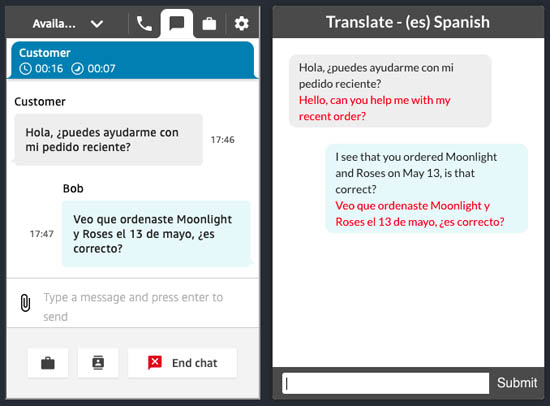
Deliveroo use case
Amazon Translate helps Deliveroo’s customers, riders (delivery personnel), and food establishment owners talk to each other across language barriers to deliver hot and tasty food of your choice from your local neighborhood eateries quickly.
This helped support the food delivery industry especially during the COVID-19 pandemic, when going out to restaurants became a hazardous endeavor.
Amy Norris, Product Manager for Deliveroo Customer Care says, “Amazon Translate is fast, accurate, and customizable to ensure that food item names, restaurant names, addresses, and customer names are translated correctly to create trustful conversational connections in uncertain times. By using Amazon Translate, our customer service agents were able to increase their first call resolution to 83% and reduce the average call handling time for their customers by 20%.”
Clean up
When you have finished experimenting with this solution, you can clean up your resources by removing the sample live chat translation application and deleting your test Amazon Connect instance.
Conclusion
The combination of Amazon Connect and Amazon Translate enables a scalable, cost-effective solution for your customer support agents to communicate in real time with customers in their preferred languages. The sample application is provided as open source—you can use it as a starting point for your own solution. AWS Professional Services, VoiceFoundry, and other Amazon partners are here to help as well.
We’d love to hear from you. Let us know what you think in the comments section, or using the issues forum in the sample solution GitHub repository.
About the Authors
 Bob Strahan is a Principal Solutions Architect in the AWS Language AI Services team.
Bob Strahan is a Principal Solutions Architect in the AWS Language AI Services team.
 Daniel Bloy is a practice leader for VoiceFoundry, an Amazon Connect specialty partner.
Daniel Bloy is a practice leader for VoiceFoundry, an Amazon Connect specialty partner.
